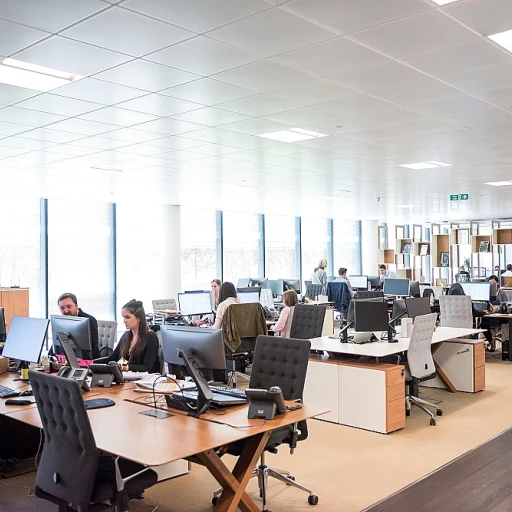
Understanding the Importance of Feedback in the Future Workplace
Why Feedback is a Cornerstone in Tomorrow's Workplace
In the rapidly evolving landscape of work, feedback has become a vital tool for growth and adaptation. As organizations strive to remain competitive, understanding the importance of feedback is crucial. Feedback, whether from employees or customers, serves as a mirror reflecting the current state of affairs and highlighting areas for improvement.
Employees, the backbone of any company, require an environment where their voices are heard and valued. This not only boosts morale but also enhances overall productivity. Encouraging employee feedback can lead to innovative ideas and solutions that might otherwise go unnoticed. Moreover, feedback fosters a sense of belonging and commitment, essential for retaining talent in an ever-changing job market.
Customer feedback, on the other hand, provides insights into the customer experience and satisfaction levels. By actively soliciting feedback from customers, businesses can tailor their services and products to better meet customer needs, ultimately improving customer satisfaction and loyalty. This is especially critical in today's digital age, where social media and online reviews can significantly impact a brand's reputation.
Radical candor, a concept popularized by business leaders, emphasizes the importance of open and honest communication. By promoting a culture of candor, organizations can create an atmosphere where feedback is not only accepted but actively sought. This approach can help teams and individuals grow, leading to a more cohesive and effective workplace.
As we look to the future, the role of feedback in shaping organizational growth cannot be overstated. It is a tool that, when used effectively, can drive innovation, improve employee engagement, and enhance customer relationships. For more insights on how feedback can influence the future of work, consider exploring what lies ahead in employee engagement.
Digital Tools for Gathering Feedback
Harnessing Technology to Gather Employee and Customer Feedback
In the modern workplace, effectively gathering feedback is crucial for sustainable growth and enhancing both customer experience and employee satisfaction. The advent of digital tools reshapes how we solicit feedback from various stakeholders. These technologies simplify the feedback process, boost transparency, and ultimately lead to a more robust understanding of the customer and employee needs.
Here is a breakdown of how to capitalize on digital tools for effective feedback collection:
- Surveys and Questionnaires: Deploying online surveys presents a direct way to receive feedback from employees and customers. These can be structured or open-ended to encourage detailed responses. Crafted correctly, they can reveal insights into specific areas for improvement. Leveraging different types of questions helps tap into nuanced aspects of employee experiences and customer satisfaction.
- Social Media Monitoring: Utilizing social media platforms for customer feedback collection is a burgeoning approach. These platforms function as real-time feedback mechanisms, allowing for the spontaneous sharing of experiences and sentiments. Monitoring this space helps organizations promptly address concerns and perceptions.
- Employee Feedback Platforms: Dedicated tools for gathering employee feedback can facilitate a continuous dialogue. By fostering an environment where radical candor is encouraged, organizations can better understand the needs and challenges their teams face.
- Integrated Feedback Systems: Systems that integrate both employee and customer feedback enhance the ability to track and analyze data efficiently. These platforms tie feedback to specific actions or customer service interactions, making it easier to identify trends and opportunities for growth.
Effectively utilizing these digital tools not only enhances organizational growth but also significantly contributes to retaining your top talent. A strategic approach to collecting feedback, powered by modern technology, ultimately empowers an organization to make informed decisions and improve both individual and company performance.
Creating a Culture of Open Communication
Fostering a Transparent Environment
In an evolving workplace, establishing a culture of open communication is crucial for gathering effective employee feedback. When people feel safe to express their thoughts candidly, they are more likely to share insightful ideas and constructive criticism. Creating an environment where radical candor is encouraged helps facilitate genuine conversations, ultimately enhancing team dynamics and organizational growth. One way to promote candor is by regularly soliciting feedback from employees. Regular surveys and open-ended questions provide staff members with the opportunity to share their experiences and perspectives. Encouraging employees to take the time to provide honest opinions, both about their own work and the processes within the organization, can help identify areas for improvement. Additionally, allowing time for these conversations during team meetings fosters a culture of transparency.Empowering Employees through Feedback
Creating channels for employees to actively provide feedback on their customer interactions is equally important. Feedback from customer experiences, gathered through customer feedback surveys or social media interactions, can significantly enhance customer satisfaction and service. Moreover, customers can offer insights that employees might overlook, creating a richer understanding of the workplace environment. By empowering teams to voice their thoughts and embedding open communication into workplace culture, businesses can improve both employee morale and customer service. Consider creative ways to solicit feedback, such as through book demos or dedicated feedback sessions. It is imperative not only to solicit feedback but also to act on it, demonstrating that employee contributions are valued and impactful. To learn more about fostering a supportive and engaging workplace, consider exploring the significance of embracing employee well-being for future success. A well-nurtured environment is the cornerstone of open communication and a thriving feedback culture.Overcoming Challenges in Feedback Collection
Confronting Obstacles in Collecting Feedback
Gathering feedback in the shifting landscape of work can be a challenging task. It's essential to address these challenges effectively to ensure a smooth process that truly benefits the organization and its people. First, one of the principal hurdles is encouraging employees and customers alike to engage openly. People might hesitate to provide honest feedback due to fears of backlash or simply because they don't think their input will lead to meaningful change. It's crucial for organizations to foster a culture where radical candor is welcomed, allowing individuals to voice their opinions without concern. Time constraints are another persistent issue in the feedback ecosystem. Employees and customers often find themselves bombarded with numerous responsibilities, leaving little room to participate in surveys or feedback sessions. Being mindful of their time and offering flexible ways to collect input, such as brief surveys or open-ended questions in casual settings, can be a step towards more inclusive feedback mechanisms. The integration of digital tools can also pose its challenges. While these tools make it easier to solicit feedback from a wider audience, they sometimes lack the nuanced understanding a face-to-face conversation might offer. Thus, it's essential to balance the use of technology with personal interactions to maintain the depth and quality of feedback collected. Lastly, dealing with unfiltered or negative feedback can be daunting. However, instead of dismissing these critiques, they should be viewed as opportunities for growth. Leadership plays a critical role in transforming such feedback into actionable insights, fostering a constructive environment for development. By identifying and overcoming these challenges, organizations can implement a feedback process that not only gathers valuable insights but actively contributes towards employee satisfaction and improved customer experience.The Role of Leadership in Feedback Processes
Embodying Leadership in the Feedback Ecosystem
Leadership plays a pivotal role in fostering a robust feedback ecosystem. When leaders prioritize effective communication and transparency, employees are more likely to engage openly, enhancing the receptiveness to feedback. Leaders must model the behavior they wish to cultivate within their teams. By demonstrating radical candor, leaders can encourage an environment where open-ended questions and constructive criticism become the norms. This approach doesn't just benefit employee feedback but extends to customer feedback as well. When leaders value input from employees on the ground, the insights gathered can significantly improve customer service and overall customer satisfaction. Leaders should also acknowledge the time and effort employees put into providing feedback. By recognizing and responding to employee contributions, leaders help build trust and bolster a sense of community within the organization. It is crucial for leaders to not only ask for feedback but to act upon it, demonstrating that employees' voices can influence change. Moreover, integrating creative ways to solicit feedback within organizational practices can drive engagement. From simple surveys to more interactive sessions, varying the feedback collection methods can lead to a more comprehensive understanding of both employee and customer experiences. Finally, the role of leadership extends beyond just receiving feedback; it involves creating initiatives that are directly informed by solicited feedback. By doing so, leaders can significantly enhance the customer experience, ensuring that the feedback loop is effective and leads to tangible improvements in both employee and customer relations.Measuring the Impact of Feedback on Organizational Growth
Assessing the Effect of Constructive Feedback on Growth
Measuring the impact of feedback on organizational growth involves taking a close look at how well businesses can adapt and evolve through insights gained from employees and customers. When feedback is integrated into the business model, it can play a crucial role in driving improvements and innovations across the board. Having a systematic approach to analyze feedback from both employees and customers will help in understanding areas of strength and weakness. Using surveys with open-ended questions can foster more insightful and candid responses, providing a broader perspective on what changes can benefit the company. To truly leverage feedback effectively, organizations should consider these key points:- Implementing a Robust Feedback Mechanism: Regularly soliciting feedback from both employees and customers allows organizations to decode patterns related to satisfaction and areas needing improvement. This can be critical in elevating customer experience and enhancing employee engagement.
- Tracking Responses Over Time: It's not enough to simply collect feedback. Organizations should aim to track trends over time, observing how adjustments based on feedback have impacted outcomes. This can inform whether strategies need further adjustment or if they are yielding expected results.
- Aligning Feedback with Business Goals: For feedback to drive tangible growth, it’s essential that responses be aligned with the company's strategic objectives. Radical candor when receiving feedback can ensure alignment of purpose between team efforts and organizational vision.












